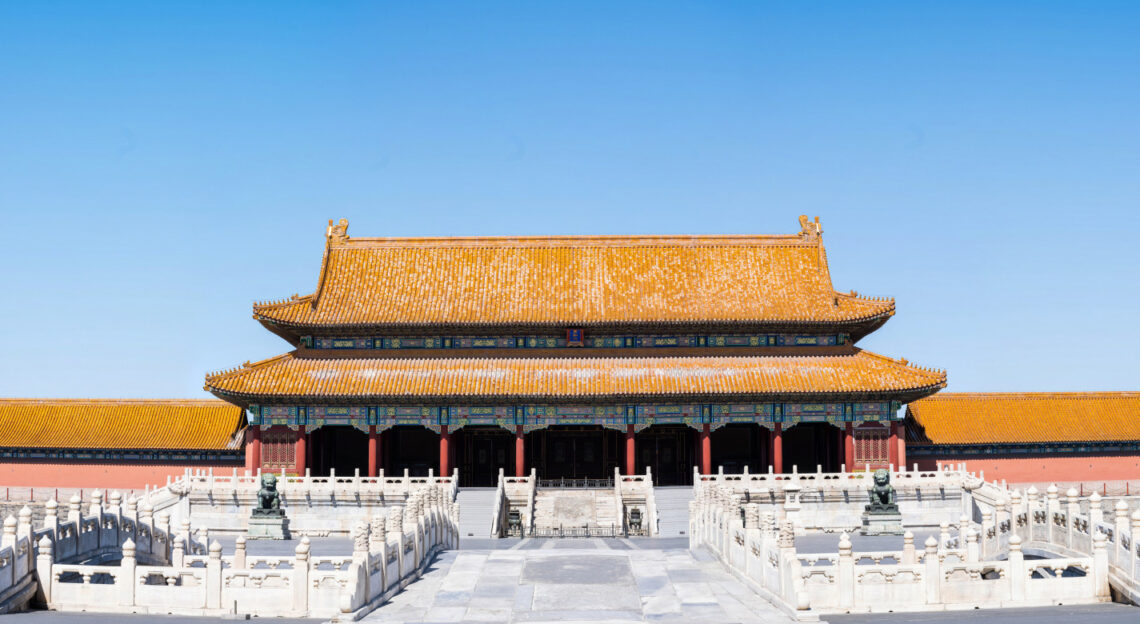
10 Must-See Highlights when visiting the Forbidden City in 2025
The Forbidden City, the red fortress where ancient secrets lie dormant, hides countless heart-stopping stories behind its magnificent palaces and quiet gardens. Every brick and tile here may hide a secret that changes history, and every treasure may tell a dusty legend. Today, let us unveil this layer of mystery together, open a mystery tour of the Forbidden City, looking for those precious memories forgotten by time.
Bronze Lions at the Gate of Supreme Harmony
There are countless dragons in the Forbidden City, but there are only six pairs of lions, and the largest pair is here at the Gate of Supreme Harmony. The west side is a male lion, strong left hand pressed on the countertop, with the right hand to hold down an embroidered ball wrapped with ribbons, symbolizing the unity of the four seas (mastery of the Jikji); the east side of the lioness, with the left hand gently hold down a small lion, like in the playful. Little lion lying on its back with its face to the sky, with four paws against the mother’s paws, but also mischievous mouth to hold the mother’s toes, very interesting, symbolizing the prosperity of the heir.
According to history, lions were introduced to China as a gift from the West during the Han Dynasty. Although the Chinese never saw a real lion, the animals became a symbol of protection and power. Over time, the image of the lion has drifted away from its true appearance. The number of curls in a lion’s mane is also significant: the lions in the Forbidden City have 45 curls on their heads, a number that suggests “Nine or Five”.
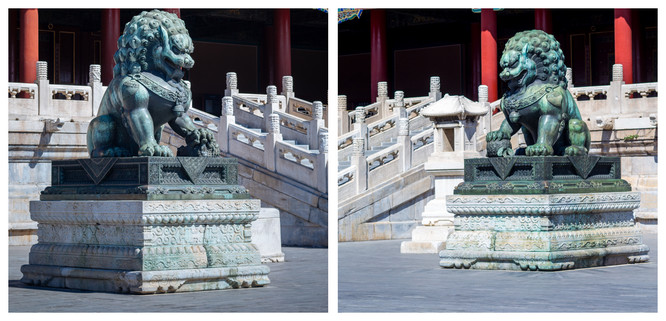
The 10 ridge beasts on the eaves of the roof of the Hall of Supreme Harmony
As the highest-ranking palace in the Forbidden City, the number and types of ridge beasts on the roof of the Hall of Supreme Harmony highlight the supremacy of the Royal Family. These ridge beasts are distributed in the two ends of the house on the ridge, from bottom to top order are: Dragon, Phoenix, Lion, Marine Horse, Heavenly Horse, Xiayu , Suanni , Xiezhi, douniu, Hangshi.

The Huge Stone Carving behind the Hall of Preserved Harmony
The most attractive part of the Hall of Preserved Harmony is the Huge Stone Carving behind it, which is 16.57 meters long, 3.07 meters wide, 1.70 meters thick and weighs more than 200 tons. Nine lifelike flying dragons are carved on the stone, and at the feet of the dragons are auspicious clouds and mountains. The stone comes from Fangshan, southwest of Beijing. In winter, people drew water from wells and splashed it on the road to make it freeze. This allowed workers and mules to drag the stone across the ice. Even with this method, more than 20,000 men and 2,000 mules were needed and could only advance about 3 kilometers per day. It was ultimately a difficult 28-day trek to get here.

Gate of thriving imperial clan Arrowhead – A Historical Alert
During the Qing Dynasty, rebellions broke out in Henan, Shandong and Beijing. Some of the rebels, with the help of some eunuchs in the palace, managed to infiltrate and attack the core of imperial power. They reached the area where the Office of Military Affairs was located and broke into the emperor’s bedroom. A fierce battle broke out in the palace, which had a huge impact on the Qing Dynasty. During this conflict, an arrow was left on a plaque at the Gate of thriving imperial clan. Although there are various theories as to the origin of the arrow, the arrow became a witness to history and served as a wake-up call to the rule of the Qing Dynasty, and was ordered by Emperor Jiaqing not to be pulled out, and thus it has been preserved to this day.
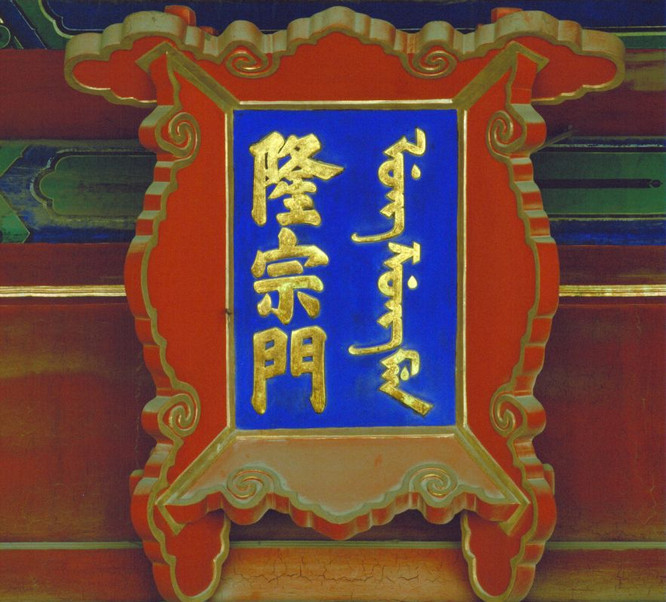
The smallest palace in the Forbidden City – the Jiangshan Sheji Halls
The smallest palace in the Forbidden City is the Jiangshan Hall and Sheji Hall,Side length is only about 1 meter, total height of about 1.4 meters, the area is even less than 10 square meters, but its status in the Forbidden City is unparalleled.
It is located in front of the Palace of Heavenly Purity (Qianqinggong) on both the east and west sides, respectively, there are two three-storey Wen stone platform, the stone platform on each side of a body gilded miniature palace, known as the Jiangshan Hall and Sheji Hall.
The east side of the Golden Palace called Jiangshan Hall, the west side of the Golden Palace called the Sheji Hall. The historical background of the Golden Hall of Jiangshan and Sheji can be traced back to the 13th year of Shunzhi’s reign (1656), when Emperor Shunzhi ordered that the gods Jiangshan and Jikji be installed in front of the Qianqing Palace, and officials were sent to make sacrifices.
In this context, “Jiangshan” refers to rivers and mountains, symbolizing state power, and “Shaji” refers to the gods of grain and land, symbolizing the land.
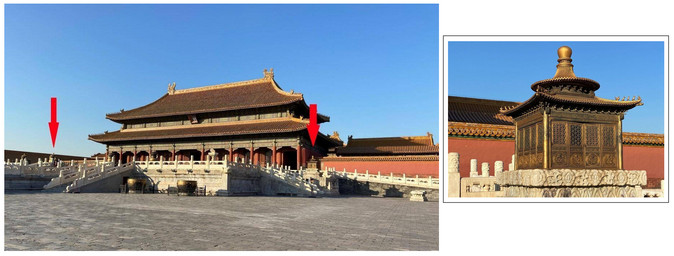
The Hall of Heavenly Purity -A signboard inscribed with “Upright and Pure in Mind” (“Zhengda guangming” in Chinese)
The signboard inscribed with “Upright and Pure in Mind” is an ink and paper plaque written by the Emperor Shunzhi of the Qing Dynasty and hangs in the main hall of the Qianqing Palace of the Forbidden City. The four words “Zheng Da Guang Ming” on the plaque mean frankness of heart, words and deeds. These four words not only reflect the integrity of the Qing Dynasty, but also imply that the long-lasting stability of the throne needs to follow the laws of heaven and earth, and conform to human nature.
The signboard inscribed with “Upright and Pure in Mind” hidden behind the Prince’s fate of the “Crown Prince box”. Since the Yongzheng dynasty began, in order to ease the throne between the emperor’s son to seize the secret struggle, the Qing dynasty adopted a secret way to build the reserves. The emperor did not openly set up the crown prince, but secretly write the selected heir to the throne of the instrument, in duplicate, a copy on the side of the emperor, a sealed in the “built reserves box”, put “bright” behind the plaque. After the death of the emperor, by the ministers of the joint removal of the “building reserves box”, and the emperor secretly hidden in the side of a cross-check, after verification, announced the heir to the throne. This system ensures a smooth transition of succession to the throne, Qianlong, Jiaqing, Daoguang, Xianfeng four emperors are according to this system on the throne.
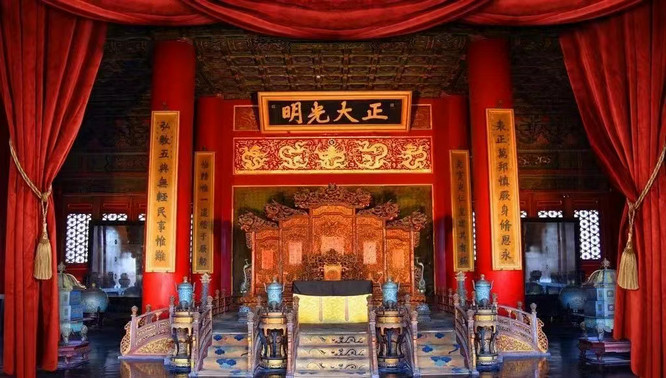
The Most Beautiful Rotten Building-The Palace of Prolonging Happiness (Yanxigong)
The Palace of Prolonging Happiness (Yanxigong), built in the eighteenth year of the Ming Yongle (1420), the first name of the Palace of longevity, later renamed Palace of Prolonging Happiness.
In the Ming and Qing Dynasties, The Palace of Prolonging Happiness was mainly used as the residence of the concubines in the harem. Due to its relatively remote location and frequent misfortunes such as fires, it was often assigned to concubines of lower status or not favored by the emperor.
In the first year of Xuantong, the construction of the Western-style building “Lingzhaoxuan”, although ultimately not completed due to the demise of the Qing Dynasty, but this “bad building” is still standing in the Palace of Prolonging Happiness, becoming a unique landscape of the Forbidden City in the ancient architecture.
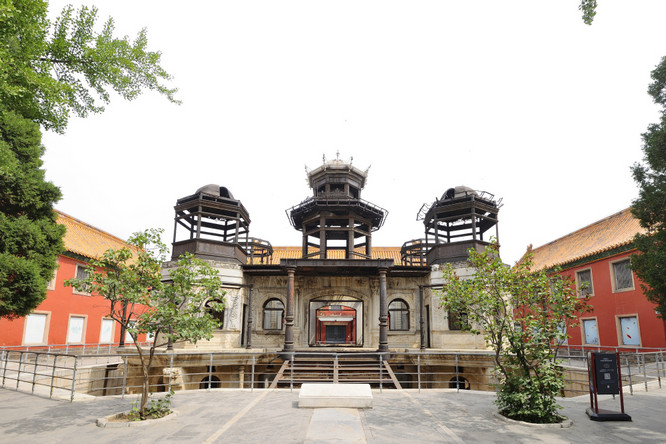
The Most Beautiful Algae Wells in the Imperial Garden (Qianqiu Pavilion and Wanchun Pavilion)
Though it was rebuilt in the late Qing Dynasty, Qianqiu Pavilion Algae Well still stands quietly in the corridor of time with its unique charm. The overall shape is unique and elegant, and the algal well in it is the finishing touch of the whole building, showing the extraordinary artistic value.
Its design is carved from golden nanmu wood, which still retains its original color. The sunlight pouring in through the windows creates a marvelous light and shadow effect, especially during the winter solstice, when a beam of sunlight shines right on the dragon’s head at about 3:00 p.m., creating an amazing visual spectacle.
With the Qianqiu Pavilion algae well echoed the Imperial Garden East Road Wanchun Pavilion algae well, is a genuine original of the Ming Dynasty. Although the color is slightly old, even with a slightly dirty old feeling, but this can not hide its rigorous workmanship and exquisite craftsmanship. The structure of Wanchun Pavilion’s algal well is skillfully designed, and the articulation between the various parts is seamless, constituting a solid and harmonious whole, which is still as stable as Mount Taishan even after hundreds of years of wind and rain.

The Nine-dragon Wall in the Forbidden City
The Nine-dragon Wall of the Forbidden City in Beijing, located in the eastern part of the Forbidden City, behind the Huangji Gate in the the Palace of Tranquil Longevity, is a shadow wall engraved on the back of the palace wall.
The Nine-dragon Wall, built in the 17th year of Qianlong in the Qing Dynasty (1772), is 29.4 meters long, 3.5 meters high and 0.45 meters thick. The top of the wall is covered with glazed tiles, and the eaves are decorated with imitation wooden structure of arch, beam square and eaves rafters. The wall is decorated with blue and green cloud and water patterns, creating an atmosphere of vastness. Nine dragons using high-relief process, the dragon body part of the wall protrudes 20 centimeters, very three-dimensional sense.
The Nine-dragon Wall of the Forbidden City and Shanxi Datong nine dragon wall, Beijing Beihai Park nine dragon wall and known as “China’s three big nine dragon wall”.

Jade Mountain (based on) the Picture “Great Yu Controlling the Waters” (Da Yu zhi shui tu yushan)
It is a Qing dynasty court jade artifact from the Qianlong period, reputed to be one of the largest jade sculptures in the world, and is now housed in the Leshou Hall in the Ningshou Palace of the Palace Museum in Beijing.
The sculpture is 224 centimeters high (excluding the base), 96 centimeters wide, with a 60-centimeter-high base, and weighs about 5,000 kilograms. It was carved from blue jade from Mount Muleta in Hotan, Xinjiang, and shows scenes of mountains, waterfalls, ancient forests, and deep caves that depict the epic story of Dayu’s water cure.
The process of carving the ade Mountain (based on) the Picture “Great Yu Controlling the Waters” was extremely complex and arduous, and the entire carving process took nearly 10 years until 1787, the fifty-second year of the Qianlong reign.

Conclusion
The Forbidden City is not only a museum, but also a vivid testimony to the 5,000 years of Chinese civilization. Every time we gaze at its red walls and yellow tiles, it is a deep look at history.
It reminds us that no matter how the times change, those treasures carrying the national memory and wisdom are always worth guarding with all our hearts.




